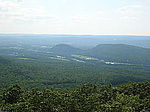Mount Sugarloaf State Reservation
Deerfield, MassachusettsParks in Franklin County, MassachusettsPocumtuck RangeState parks of MassachusettsUse mdy dates from August 2023

Mount Sugarloaf State Reservation is a state-owned, public recreation area managed by the Massachusetts Department of Conservation and Recreation located in South Deerfield, just west of the Connecticut River. The state park includes the summits of North Sugarloaf Mountain and South Sugarloaf Mountain, as well as 1.75 miles of frontage on the Connecticut River and two river islands. The park is part of a larger park designation called the Connecticut River Greenway State Park. Portions of the park property along the river are used by the University of Massachusetts Amherst for agricultural research.
Excerpt from the Wikipedia article Mount Sugarloaf State Reservation (License: CC BY-SA 3.0, Authors, Images).Mount Sugarloaf State Reservation
Sugarloaf Mountain Road,
Geographical coordinates (GPS) Address Nearby Places Show on map
Geographical coordinates (GPS)
| Latitude | Longitude |
|---|---|
| N 42.47 ° | E -72.592222222222 ° |
Address
Sugarloaf Mountain Road
Sugarloaf Mountain Road
01373
Massachusetts, United States
Open on Google Maps








